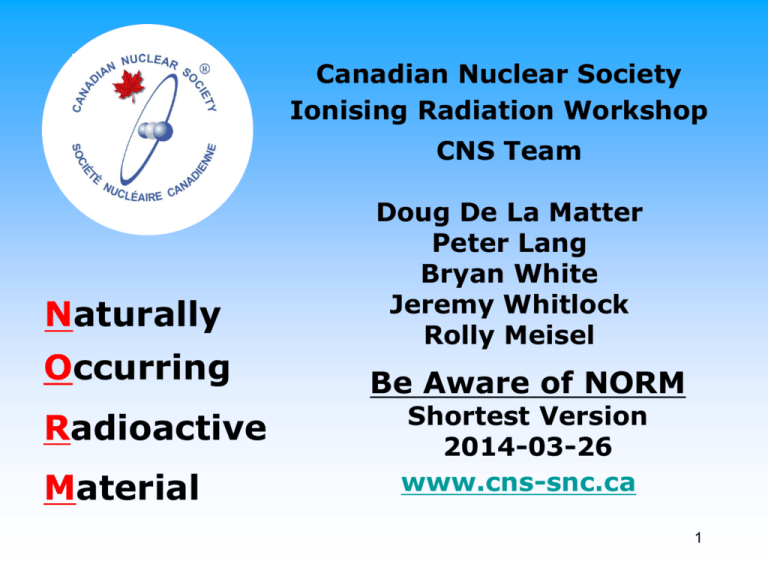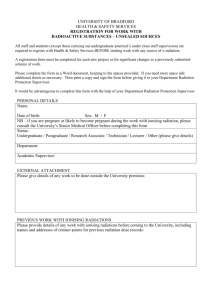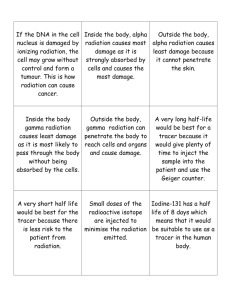Power Point Presentation
advertisement

Canadian Nuclear Society Ionising Radiation Workshop CNS Team Naturally Occurring Radioactive Material Doug De La Matter Peter Lang Bryan White Jeremy Whitlock Rolly Meisel Be Aware of NORM Shortest Version 2014-03-26 www.cns-snc.ca 1 The ionising radiation workshop kit… Geiger counter USB Interface Computer If your table has a computer, please don’t disturb it -- we’ll get to it shortly. 2 www.cna.ca 7 8 http://www.nuclearconnect.org/ 9 So why does the CNS provide this workshop? • We believe that students will benefit from simple, personal, practical demos / experiments that enrich their classroom experience. • We’re convinced that investing in science teachers is the best way we can help improve public understanding of ionising radiation. 10 Program for Today: • Electromagnetic Radiation • Particle Radiation • Ionising vs Non-ionising Radiation • Radioactive Decay and background • Detecting Radiation • Experiments with a Geiger Counter 11 What is Radiation? • Energy emitted by a source travelling through space away from the source. • Most radiation we encounter is Electro-Magnetic radiation and behaves like visible light. I’m a wave! I’m a particle! (0 rest mass) Just call me a photon. 12 Particle Radiation • Radiation can also refer to sub-atomic particles: – most have finite “rest mass” – Electrons, protons, neutrons, alpha particles, muons, pions, neutrinos, …? • Particles may be released from an atomic nucleus undergoing radioactive decay, or fission, or by an interaction such as “scattering”. • Particles may be produced by interactions of other particles -- or may be produced by a particle accelerator. 13 Electromagnetic Radiation non-ionising ionising Figure copied from “Radiation Awareness” PowerPoint File by Health Physics Society, crediting NASA/JPL-Caltech Notice that cell phone radiation falls well into the “non-ionising” region of electromagnetic radiation. 14 Radioactive Decay • A radioactive atom has excess energy in its nucleus, but not quite enough to change to a lower energy state, and then... …spontaneously it changes to a lower energy state. • It does this by emitting sub-atomic particles… …and/or electromagnetic energy in the form of gamma radiation… …through quantum-mechanical tunnelling and other mechanisms. • One decay per second is known as one becquerel (Bq) of activity. 15 protons www.nndc.bnl.gov/chart/ Radioactive Decay Half-life: after 1 half-life, half of starting number of atoms of an isotope remain undecayed neutrons Online Interactive Chart of the Nuclides http://www.nndc.bnl.gov/chart/ 18 Alpha Radiation • Heavy nuclei that have “2 too many protons” will emit particles made up of 2 protons and 2 neutrons. • These are known as “alpha particles” (the nucleus of a helium atom, 4He+2) • After alpha emission, there is a nuclide with a different atomic number (a different element): this is known as transmutation. • The resulting nuclide may or may not be radioactive itself. Atomic Number -2, Mass -4 19 Beta Radiation - 1 • A nucleus that has “1 too many neutrons” will emit an electron – a beta-minus particle – A neutron changes into a proton, an electron and an anti-neutrino – The electron and anti-neutrino are emitted – along with a photon (gamma) in many cases • After beta emission, there remains a nuclide with a different atomic number – a different element. • The new nuclide may or may not be radioactive itself. Atomic Number +1, Mass 20 Beta Radiation - 2 • A nucleus that has “1 too many protons” will capture an orbital electron, or emit an anti-electron – a positron – a beta-plus particle – A proton changes into a neutron by: • combining with an electron and emitting a neutrino • OR by emitting a positron and a neutrino – This form of beta decay also emits a photon (gamma) in most cases. • There remains a nuclide with a different atomic number – a different element. • The new nuclide may or may not be radioactive itself. Atomic Number -1, Mass 21 Gamma Radiation • Highest energy EM radiation • Interaction with matter similar to X-rays • “Collision” with an electron can ionise the atom, breaking a chemical bond. 22 Gamma Radiation • Easily penetrates the body • Intense sources (Co-60, Cs-137 and high energy electron accelerators) are used to irradiate tumors • Absorbed by large thickness of water, lead metal or concrete • The atmosphere over your head provides shielding equivalent to 10 m of water 23 Radioactive Decay • If we start with 100 atoms of a particular nuclide, after a certain time we will have 50 of those atoms left. • This is known as the “half-life” of the nuclide. • After another “half-life”, we will have 25 of those atoms left . 100% 90% 80% 70% 60% 50% 40% 30% 20% 0.39% 10% 0% 0 1 2 3 4 5 6 7 8 24 Non-Ionising Radiation • Does not displace electrons from atoms. • Can break chemical bonds due to heating effects. • Includes radio waves, microwaves, infrared radiation, visible light, and some UV. • Microwaves couple to molecular vibrations and rotation. • Visible light couples to atomic electron quantum state transitions. 25 Ionising Radiation • Able to displace electrons from atoms, often breaking chemical bonds. • Includes ultraviolet light, x-rays, and gamma rays from the electromagnetic spectrum. • Includes alpha particles, beta particles, neutrons, protons and (extremely rarely) neutrinos. Sudbury Neutrino Observatory (SNO) 2015 Dr. Art McDonald corecipient of Nobel Prize in Physics! 26 Transmutation of Elements Rn decays to 218 84 Po via α-emission 222 86 Atomic number 2 Mass number 4 220 84 Po decays to 220 85 At via β-emission Atomic number 1 Mass number is unchanged 27 Background Radiation We are all exposed to ionising radiation – and most of that is natural background radiation Natural Background 73% Medical Sources 25% Living at the boundary of a nuclear station 1% Other Sources 1 % The dose we absorb each year in Sieverts (Sv) from background varies with geology & geography by a factor of 100 Inhalation (Radon) - 1.2 mSv External Terrestrial - 0.48 Cosmic Radiation - 0.4 Ingestion - 0.3 28 Detecting X-rays, Gamma Rays and Particles • Photochemical films • Cloud Chambers (track detectors) • Scintillators (NaI – Li, liquid) • Solid state detectors (GeLi, thermoluminescent) • Gas discharge (Geiger detector) PLEASE Don’t Break the Window! 29 The Geiger Detector • Ionising radiation scatters off atoms in the detector, removing electrons from their atoms. • Free electrons are accelerated toward a positively charged anode (~500V DC). • These electrons ionise additional atoms in the gas space, leading to an avalanche discharge. • Electronics detect the discharge current pulse. • The counter can detect ONE event at a time. • It cannot distinguish between one ionising event and many events occurring within the dead-time interval. 30 Experiment 1: Background Radiation • Ionising radiation is everywhere. • Background “measurements” can be tricky and time consuming. • Short counting intervals give small average numbers of counts leading to unreliable statistics. • Long counting intervals can be tedious. • The effect of shielding is easy to show. • A container of water provides shielding to reduce background count 31 Find the background running average on your screen Workstation Running Average 1 2 3 4 5 6 Average for 6 32 Experiment 1: Background and Shielding Counting for 10 minutes may not produce consistent results 33 The Hot Balloon Experiment Experiment 4: The balloon experiment NEW • The balloon is an electrostatic precipitator collecting dust particles from the air. • The α decay of 222Rn (3.82 day) to: 7. 218Po (3.1 min) – α 8. 214Pb (26.8 min) – β- 9. 214Bi 10. 214Po (19.9 min) – β- These dominate the balloon data (164 µs) – α 11. 210Pb (22.2 year) – β12. 210Bi (5.012 day) – β13. 210Po (138.4 day) – α 14. 206Pb (stable) 35 Blue Balloon charged with microfibre cloth 4000 deflated balloon on Geiger 3500 paper disk atop Geiger window to Counts per minute 3000 2500 2000 1500 1000 inflated balloon on 500 0 14:52 16:04 17:16 18:28 19:40 20:52 36 Experiment 2 • You can make a simple set of measurements with weak sources such as NoSalt® • Potassium chloride (KCl) is a convenient source of K-40 available in any grocery store • Place the KCl near the Geiger window • Note the jump in counts per minute 5 kBq of 40K for ~$4.79 in grocery stores everywhere 37 Experiment 3: Th-232 in vintage camera lenses From about 1950 through to 1980, several consumer cameras were made using thorium oxide in the glass lens to: • enhance the refractive index of the glass • keep the dispersion low Such “bright” sources provide counting rates at or above 5000 counts per minute. • • • • many measurements can be made in a short time acceptable level of statistical errors students are more likely to remain engaged cameras can be found on sources such as EBay 38 Experiment 3: Th-232 in vintage camera lenses • For high school demonstration experiments, these lenses are a conveniently “bright” source of particles. • The radioactive material is embedded inside the glass of the lens, and most of the particle emissions are absorbed by air. Kodak Signet 40 camera lens 39 To get a Geiger Kit donated to your school you must ask the CNS. You might borrow one? Check the list on the CNS website to find a school nearby. Vintage Vaseline Glass: a uranium source • Uranium compounds added to glass give it a green-yellow hue and it fluoresces under UV light. • It provides alpha, beta, and gamma radiation, but is not as intense as the vintage camera lenses. 41 Vintage Fiestaware: a uranium source •Uranium compounds added to the ceramic glaze give these saucers a red-orange hue (and no they don’t fluoresce under UV light) •The maximum count rates at minimum separation with an RM-80 are about 30000 cpm and 20000 cpm for these two samples 42 Online video experiments 43 Canadian Nuclear Society Ionising Radiation Workshop Be Aware of NORM CNS Team Thanks for Your Attention www.cns-snc.ca Bryan White Doug De La Matter Peter Lang Jeremy Whitlock Rolly Meisel Additional photographs copyright R. Meisel used with permission 44 45





